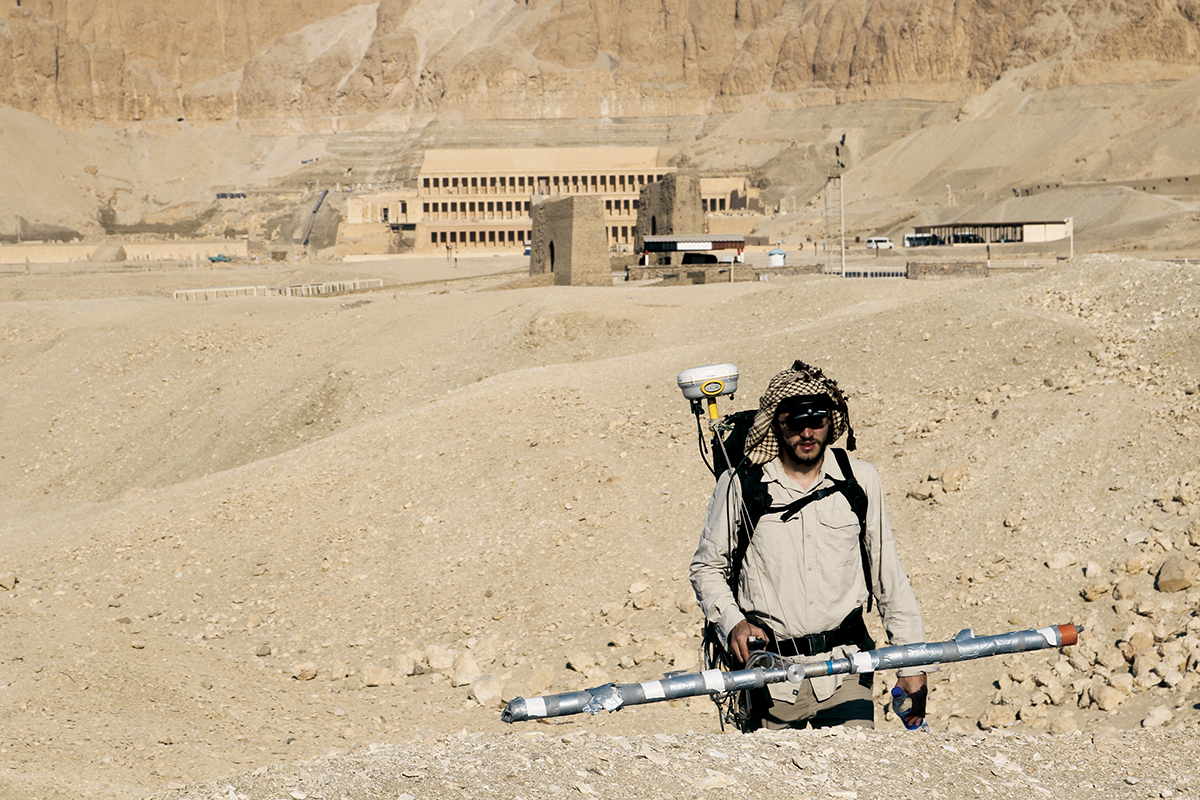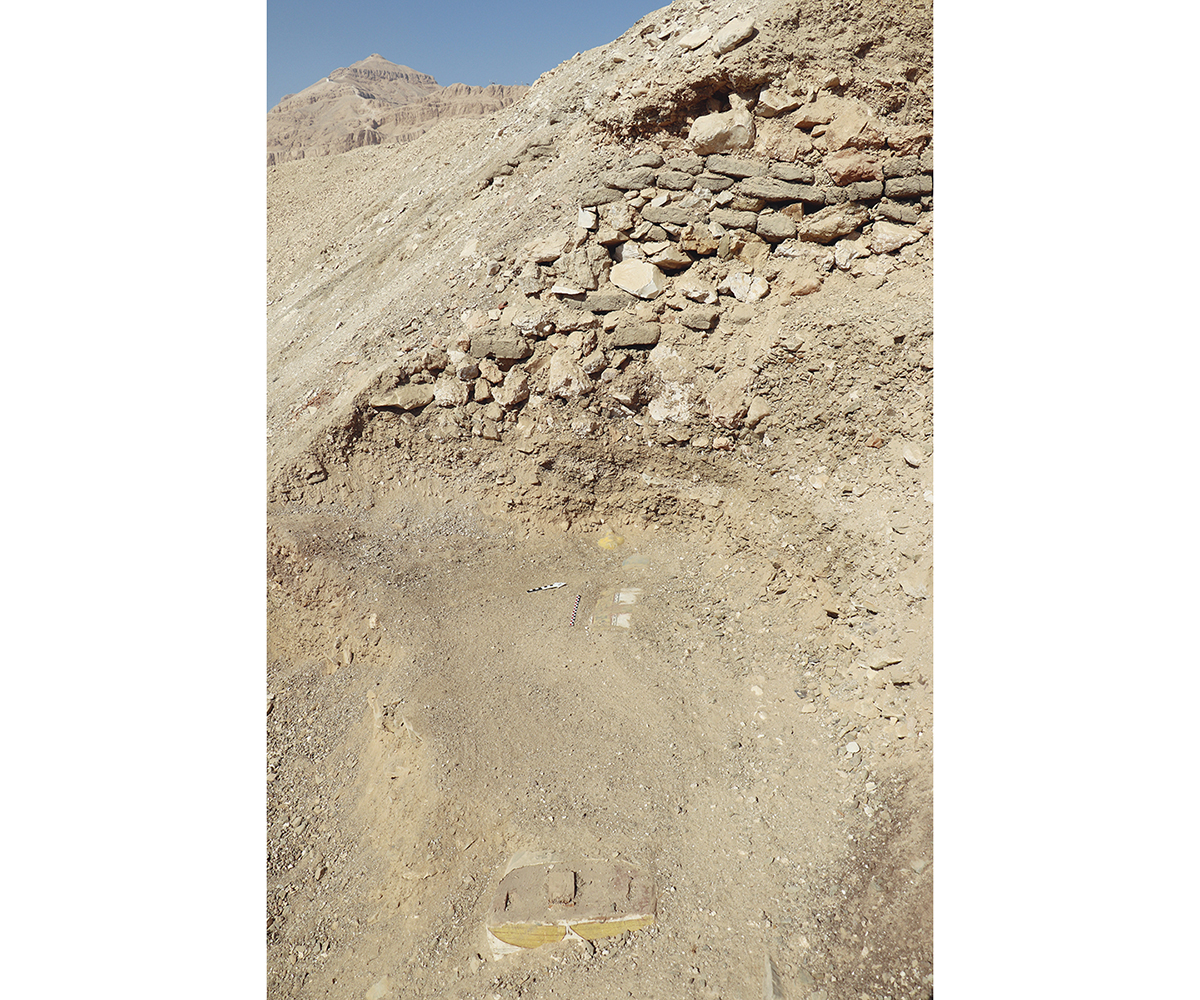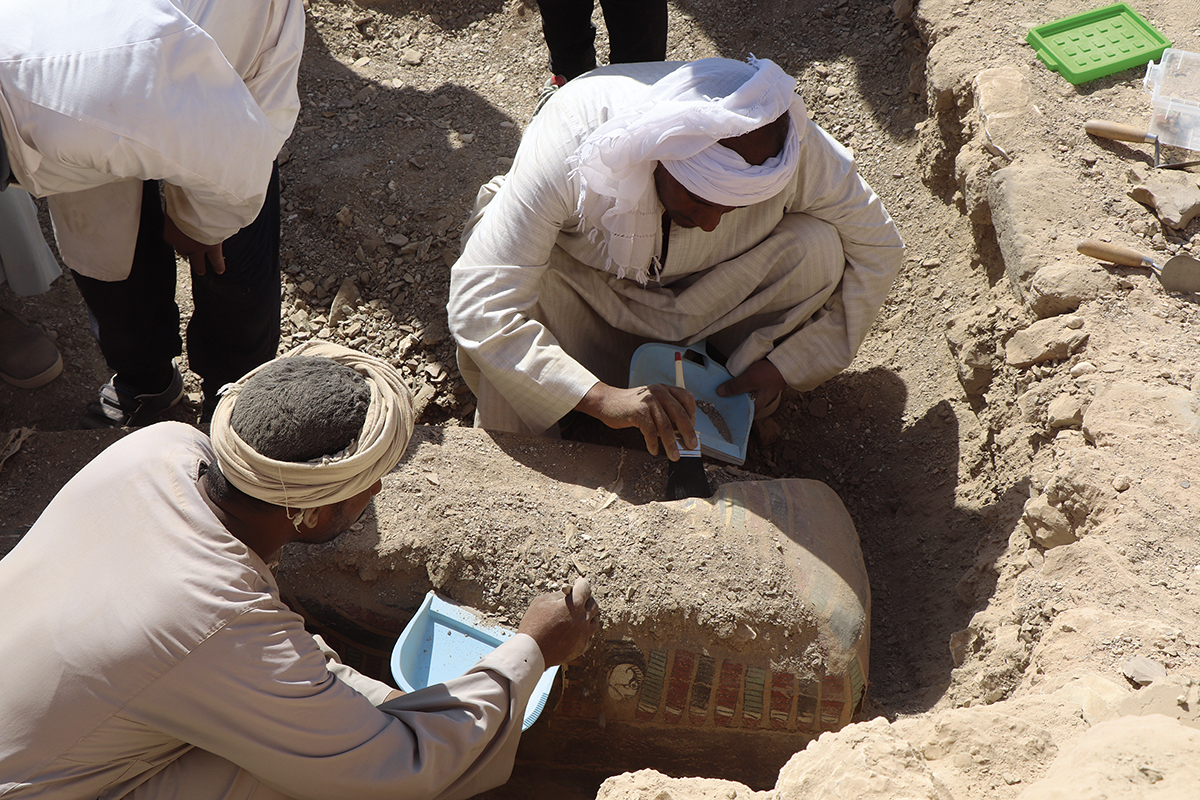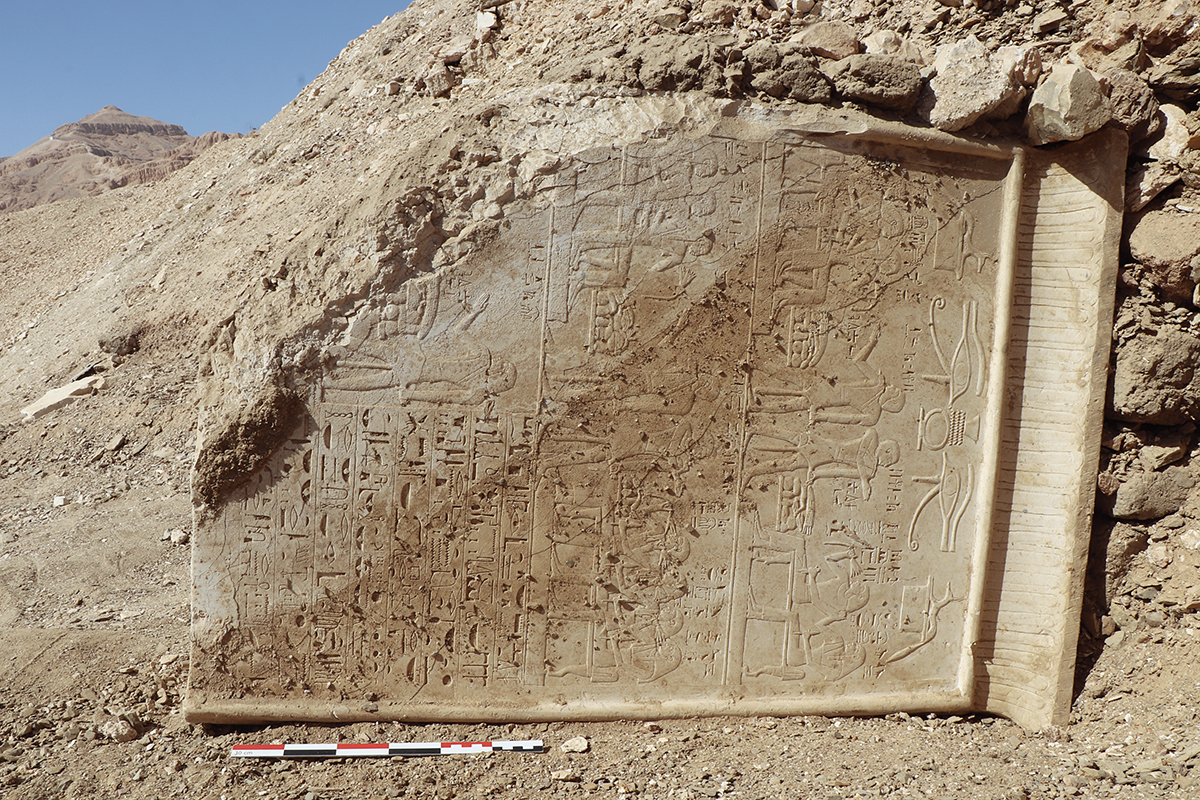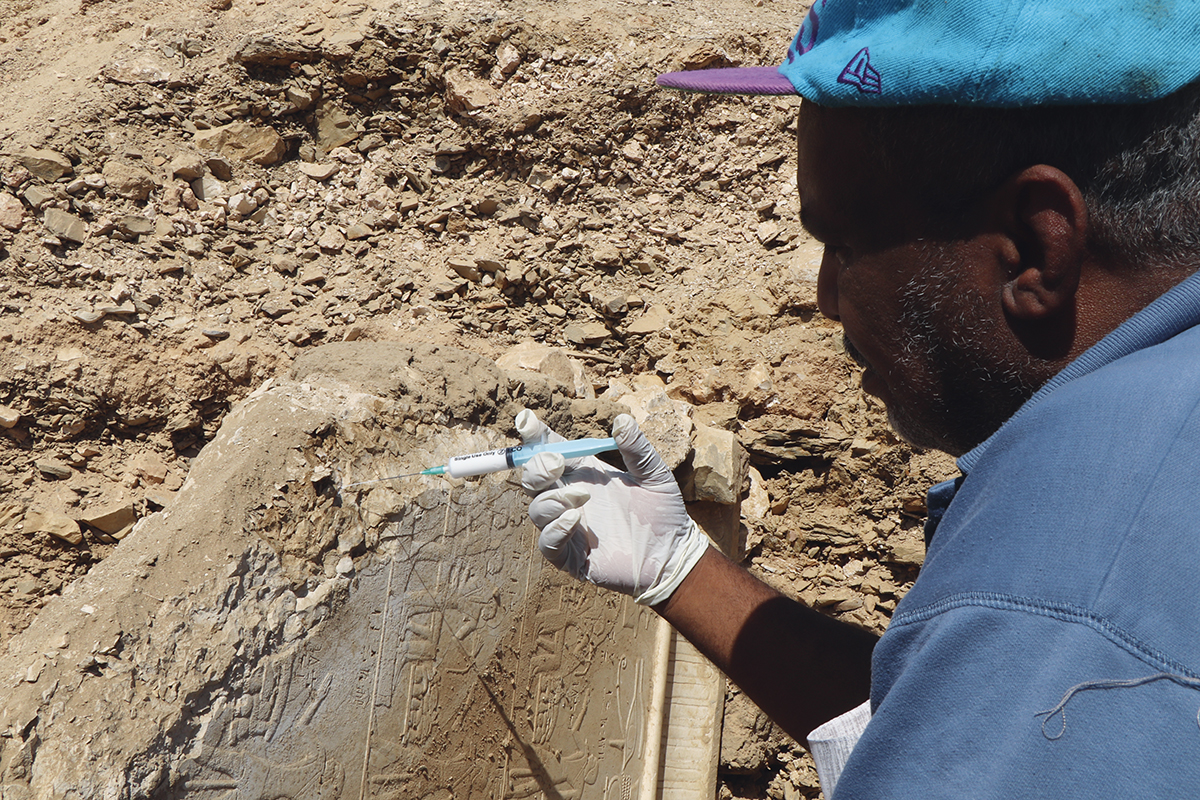Assassif
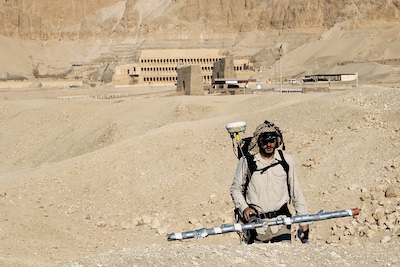
 doi doi | 10.34816/ifao.7778-6d24 |
 IdRef IdRef | 027523640 |
| Missions Ifao depuis | 2016 |
Assassif : archéologie d’une vallée funéraire et cultuelleOpération de terrain 17147
Responsable(s)


Partenaires






🔗 Université de Louxor
Cofinancements




🔗 Projet 4D Pénaménopé
🔗 CNRS, Projets exploratoires pluridisciplinaires (PEPS)
🔗 Archéologie et patrimoine en Méditerranée (ARPAMED)
🔗 Fonds Khéops pour l’archéologie
Dates des travaux
octobre - décembre
Rapports de fouilles dans le BAEFE
2022 : 10.4000/baefe.9029
2021 : 10.4000/baefe.6128
2020 : 10.4000/baefe.2895
2019 : 10.4000/baefe.985
Participants en 2025
Située en face de la ville antique qui s’étalait sur la rive droite autour des temples de Karnak et de Louqsor, cette vallée abrita du Moyen au Nouvel Empire des édifices de culte funéraire royal et divin, dont les rituels se focalisaient sur les temples de Montouhotep II, d’Hatchepsout et de Thoutmosis III. De prestigieuses tombes monumentales privées furent construites de part et d’autre des chaussées qui y menaient, pour accueillir les inhumations et le culte mortuaire de hauts fonctionnaires proches du pouvoir. À la fin de la Troisième Période intermédiaire et au début de la Basse Époque, les autorités thébaines réinvestirent l’espace central et oriental du thalweg, déjà très peuplé de structures funéraires et cultuelles, pour y installer les tombes de dignitaires au service, notamment, de l’institution de la divine adoratrice, dont l’importance religieuse et politique connut un sommet à la transition des XXVe et XXVIe dynasties. À l’aune de l’architecture funéraire privée, les dimensions de certains de ces mausolées sont véritablement exceptionnelles, en particulier celles de la TT 34 de Montouemhat ou celles de la TT 33 de Padiamenopé, dont l’emprise en surface du site définit les limites de la concession de fouille. L’Assassif conserve ainsi un véritable condensé archéologique de l’histoire des élites thébaines sur plus de deux millénaires, si l’on suit le fil diachronique jusqu’à l’époque romaine.
L’Assassif constitue non seulement un hypercentre politique et religieux au sein de la nécropole thébaine – pour adopter un vocabulaire de géographie urbaine –, mais encore, du point de vue de l’histoire des sciences, un des centres d’attraction archéologique d’une capitale de l’égyptologie de terrain depuis le XVIIIe s. Après avoir connu un développement majeur dans le dernier tiers du XXe s., notamment sous l’impulsion d’équipes italiennes, françaises, allemandes, autrichiennes (1969-1977, Manfred Bietak et alii, ensuite Julia Budka) et belges (1970-1992, Herman De Meulenaere, Erhart Graefe et alii), l’étude des tombes monumentales de l’Assassif s’est imposée comme un domaine de recherche incontournable pour l’histoire de la région thébaine (voir par exemple les conférences Thebes in the First Millennium BC, en 2012 et en 2016). Plusieurs équipes étudient ces monuments selon des points de vue divers, épigraphique, archéologique et de restauration, notamment dans les tombes de Haroua et d’Akhimenrou (TT 37 et TT 404, Francesco Tiradritti depuis 1996), de Padiamenopé (TT 33, Isabelle Régen et Claude Traunecker depuis 2004), de Montouemhat (TT 34, Farouk Gomaà et alii depuis 2006, Louise Gestermann, Christian Leitz), d’Amenhotep-Houy (AT 28, Francisco J. Martin Valentin depuis 2009), d’Henenou et de Ipi (TT 313 et TT 315, Antonio J. Morales depuis 2015). Enfin, les fouilles du ministère des Antiquités de l’Égypte ont récemment mis au jour d’importantes découvertes dans le secteur des TT 25, TT 28, TT 408 et TT 409, à quelques dizaines de mètres au sud de la TT 33, parmi lesquelles un bel assemblage d’une trentaine de sarcophages de la Troisième Période intermédiaire.
Le monument le plus vaste de l’Assassif, la tombe de Padiamenopé, est aussi connu du monde scientifique depuis le plus longtemps, car des relevés en furent réalisés déjà au XVIIIe s. par Richard Pococke et dans la Description de l’Égypte. Une première édition de textes funéraires du monument est parue dès 1884-1894 sous la plume de Johannes Dümichen, premier titulaire de la chaire d’égyptologie de l’université de Strasbourg, et un vaste programme d’édition de la « bibliothèque » pariétale de Padiamenopé est en cours sous la direction de C. Traunecker et d’I. Régen. Mais, au-delà de l’épigraphie et de l’architecture des salles souterraines, la TT 33 est sans doute le temple funéraire de l’Assassif dont le contexte archéologique est pour l’instant le moins bien connu.
En effet, aucune fouille stratigraphique susceptible de retracer l’histoire matérielle de ce secteur n’a jamais été menée. Pour combler cette lacune, un nouveau projet de fouille a été conçu en 2016 sous l’égide de l’Ifao et de l’université de Strasbourg, avec pour ligne directrice la volonté d’exploiter la position et la configuration très favorables du site pour étudier l’histoire de l’aménagement et des transformations de la vallée funéraire dans une perspective globale. En effet, la masse formée par l’enceinte de Padiamenopé et les énormes amoncellements de déblais qu’ont accumulés les bâtisseurs des tombes de la Basse Époque ont protégé une véritable « réserve » stratigraphique contre les grands dégagements d’une archéologie à échelle industrielle dans les années 1920 et 1930. En outre, l’emprise de la vaste enceinte occupe une place véritablement stratégique pour étudier les grands travaux d’aménagement de la ville funéraire au fil des siècles, car elle est traversée par le tracé putatif des chaussées de Montouhotep II et de Thoutmosis III, tandis que l’allée cérémonielle d’Hatchepsout en est mitoyenne. En outre, des fouilles menées au XXe s. au sud et à l’est de la TT 33 ont montré que l’environnement proche de la concession a archivé les vestiges des grandes phases d’extension du bâti creusé et maçonné ainsi que les décombres-témoins des périodes d’arasement et de nivellement des quartiers monumentaux préexistants. Le terrain enclos par l’enceinte de Padiamenopé offre donc l’opportunité d’ouvrir une fenêtre d’étude sur les développements et les contractions de la panoplie monumentale depuis la XIe dynastie jusqu’à la Basse Époque et au-delà.
Frédéric Colin (université de Strasbourg, UMR 7044)
Situated opposite the ancient town which used to spread along the right bank around the temples of Karnak and Luxor, during the Middle and New Kingdoms this valley included structures for the royal and divine funerary cult whose rituals focussed on the temples of Montuhotep II, Hatshepsut and Thutmose III. Magnificent private monumental tombs were constructed on either side of the roadways which led there, to welcome burials and the mortuary cult of high officials close to the seat of power. At the end of the Third Intermediate Period and at the beginning of the Late Period, the Theban authorities modified the central and west area of the depression, already tightly packed with funerary and cultural structures, to set up tombs of serving dignitaries, notably those within the institution of the Divine Adoratrice whose religious and political importance reached a peak at the transition between the 25th and 26th Dynasties.
From the perspective of private funerary architecture, the dimensions of some of these mausolea are truly exceptional, in particular those of the tomb of Montuemhat (TT 34), and of Padiamenope (TT 33), whose extent on the site’s surface defines the limits of the excavation concession. The Asasif thus comprises a truly dense archaeological resource concerning the history of the Theban elite over more than two millennia, if one follows the diachronic thread up to the Roman period.
The Asasif comprises not only a political and religious hyper-centre at the heart of the Theban necropolis (to adopt a term used in urban geography) but, from the point of view of the history of scholarship, has been one of the most significant centres of interest for Egyptological excavation since the 18th century. After a major expansion in the last third of the 20th century, notably through the impetus of teams of Italians, French, Germans, Austrians (by Manfred Bietak et alii, then Julia Budka, 1969-1977) and Belgians (by Herman De Meulenaere, Erhart Graefe et alii, 1970-1992), the study of the Asasif’s monumental tombs became an essential focus of research for the Theban region’s history (see, for example, the Thebes in the First Millennium BC conferences in 2012 and 2016). Several teams are studying these monuments from various perspectives (epigraphic, archaeological and restoration), notably in the tombs of Harwa (TT 37) and Akhimenru (TT 404) (Francesco Tiradritti from 1996), Padiamenope (TT 33) (Isabelle Régen and Claude Traunecker from 2004), Montuemhat (TT 34) (Farouk Gomaà et alii from 2006, Louise Gestermann and Christian Leitz) Amenhotep-Huy (AT 28) (Francisco J. Martin Valentin from 2009), and Henenu (TT 313) and Ipi (TT 315) (Antonio J. Morales from 2015). Finally, excavations of the Egyptian Ministry of Tourism and Antiquities have recently brought to light important discoveries in the area of TT 25, TT 28, TT 408 and TT 409, some dozens of metres to the south of TT 33. Among these is a splendid assemblage of about thirty sarcophagi which date to the Third Intermediate Period.
The most massive monument in the Asasif, the tomb of Padiamenope, has for a very long time been a subject of interest for the scholarly world, with its reliefs being copied in the 18th century by Richard Pococke and in the Description de l’Égypte. A first edition of funerary texts in the monument appeared between 1884-1894 through the pen of Johannes Dümichen, first holder of the Chair of Egyptology at the University of Strasbourg. Now a huge programme of publication of the wall-inscribed “library” of Padiamenope is in progress under the direction of C. Traunecker and I. Régen. But beyond the epigraphy and architecture of the subterranean rooms, TT 33 is without doubt the funerary temple of the Asasif whose archaeological context, for the moment, is least well known. Indeed, no stratigraphic excavations with the aim of tracing the material history of this area has ever been attempted. To fill this gap, a new excavation project was conceived in 2016 under the aegis of the IFAO and the University of Strasbourg, with the aim of taking advantage of the position and very favourable outline of the site to study, through a wide-ranging perspective, the historical development and alterations in this funerary valley.
Indeed, the magnitude of Padiamenope’s enclosure, and the enormous piles of debris accumulated by the builders of the tombs of the Late Period, have protected a stratigraphic “resource” which has survived the great industrial-scale archaeological clearances of the 1920s and 1930s. In addition, the position of the vast enclosure gives it a truly strategic significance for studying those great landscape activities which took place in the funerary city over the centuries, as it is crossed by the presumed roadways of Montuhotep II and Thutmose III, while the ceremonial way of Hatshepsut lies between them. In addition, excavations conducted in the 20th century to the south and east of TT 33 have shown that, near to the concession, lie hidden the remains of great extension phases involving digging and construction in addition to rubble which attests to periods of erasing and levelling of pre-existing monumental areas. The land enclosed by the enclosure wall of Padiamenope therefore offers an opportunity to open a window on the developments and diminishing of this monumental spectacle from the 11th Dynasty to the Late Period and beyond.
Frédéric Colin (UMR 7044)
يقع وادي العساسيف في الجهة المقابلة للمدينة القديمة التي كانت تمتدُّ على الضفَّة الشرقيَّة حول معابد الأقصر والكرنك؛ حيث كان الوادي في عصرَيّْ الدولة الوسطى والحديثة يضمُّ مباني إقامة الطقوس الجنائزيَّة المَلَكيَّة والإلهيَّة وكانت الشعائر تتركَّز على معابد منتوحتب الثاني، وحتشبسوت وتحتمس الثالث. وقد أُقيمت على جانبَيّ الطرق المؤدية إلى تلك المعابد، مقابر مَهِيبة خاصة لاستقبال الطُّقُوس الجنائزيَّة وجثامين كبار مُوظَّفي الدولة المُقرَّبين من السلطة. ففي نهاية عصر الانتقال الثالث وبداية العصر المتأخر، أعادت سلطاتُ طِيبَة استغلالَ المساحاتِ الواقعةِ بالمنطقتين الوُسْطَى والشرقيَّة من قعر الوادي والتي كانت بالفعل مُكتظَّة بالمباني الجنائزيَّة والشعائريَّة، فأقامت بها مقابرَ لكبارِ الشخصيَّات العاملة بالدولة؛ وخاصةً في مؤسسة المعبودة الإلهيَّة، والتي بلغت أهميَّتُها السياسيَّة والدينيَّة ذُرْوتَها خلال الفترة من نهاية الأسرة الخامسة والعشرين وبداية الأسرة السادسة والعشرين. وتُعدُّ أبعادُ بعض تلك المقابر الضخمة استثنائيَّةً حقًا إذا ما قُورِنَت بالعمارة الجنائزيّة غير الرسميّة؛ وخاصةً أبعاد المقبرة 34 (مقبرة منتومحات)، أو أبعاد المقبرة 33 (مقبرة پادي آمون أوپت)؛ حتى إن أبعادها الظاهرة ترسمُ حدودَ المساحةِ الممنوحة كامتياز للبَعْثَة. وبذلك يمكنُنا القولُ أن موقع العساسيف حافظ على «مُرَكَّز» أثريّ يلخِّصُ تاريخَ نبلاء مدينةِ طِيبَةَ على مدارِ ما يرْبُو على ألفَيّْ عام، وذلك إذا اتَّبعنا تسلسل الخط الزمني حتى حلول العصر الروماني.
إن موقع العساسيف لا يُمثِّل فقط مركزًا سياسيًّا ودينيًّا مهمًّا في قلب جَبَّانَة طِيبَة (وهي التسمية المستخدمة في الجغرافيا العمرانية)؛ ولكنه بالنسبة إلى مجال تاريخ العلوم، يُعدُّ أيضاً أحد مراكز الجذب الأثريّ بعاصمة علم المصريَّات الميدانيّ منذ القرن الثامن عشر. بعد أن شهدت دراسةُ المقابر الضخمة بالموقع تطوُّرًا هائلًا في الثلث الأخير من القرن العشرين؛ وخاصةً في ظل الدَّفعة التي قامت بها الفرَقُ الأثريَّة الإيطاليَّة، والفرنسيَّة، والألمانيَّة، والنمساويَّة (1969-1977، بقيادة مانفريد بيتك وآخرين، وأيضًا ﭼـوليا بودكا)؛ وكذلك الفرَق البلـﭼيكيَّة (1970-1992، تحت قيادة هيرمان دو مولينير، إيرهارت جراف وآخرين)، فرضت دراسةُ مقابر العساسيف نفسَها كمجالِ بحثٍ حتميٍّ لمعرفة تاريخ منطقة طيبة (انظر على سبيل المثال مؤتمريّ Thebes in the First Millennium BC في عامَيّْ 2012 و2016). وتدرسُ الكثيرُ من الفرَقِ تلك المعالم الأثريَّة وفقًا لوجهات نظر متنوعة تتعلق بعلم الكتابات، وعلم الآثار، والترميم؛ وخاصةً في مقبرة حاروا، وأخ آمون رو (المقبرة الطِّيبِيَّة 37، والمقبرة الطِّيبِيَّة 404، تحت قيادة فرانشيسكو تيرادريتِّي، منذ عام 1997)، ومقبرة پادي آمون أوپت (المقبرة الطِّيبِيَّة 33، تحت قيادة إيزابيل ريچان وكلود ترونيكر، منذ عام 2004)، ومقبرة منتومحات (المقبرة الطِّيبِيَّة 34، تحت قيادة فاروق جمعة وآخرين، ومنذ عام 2006، لويز جيسترمان وكريستيان لايتز)، ومقبرة أمنحوتب حوي (المقبرة 28، تحت قيادة فرانسيسكو مارتان ڨالنتان، منذ عام 2009)، ومقبرة حننو، والوزير إبي (المقابر الطِّيبِيَّة 313 و315، تحت قيادة أنطونيو مورالس، منذ عام 2015). وأخيرًا أسفرت عمليات التنقيب التي أجرتها مؤخرًا وزارةُ الآثار المصريَّة عن اكتشافاتٍ مهمَّة في قطاع المقابر الطِّيبِيَّة 25، 28، 408، 409، والتي تقع على بُعد عشراتِ الأمتارِ من جنوبِ المقبرةِ الطيبية 33. من بين تلك الاكتشافات، مجموعةٌ أثريَّةٌ رائعةٌ تضمُّ ثلاثين تابوتًا يرجع تاريخُها إلى عصر الانتقال الثالث.
إن أضخم المعالم الأثريَّة في موقع العساسيف، مقبرة پادي آمون أوپت، كانت معروفةً في الأوساط العلميَّة منذ زمن بعيد؛ حيث أُجريت عمليَّات الرفع بها في القرن الثامن عشر على يد ريتشارد پوكوك، كما ذُكر في كتاب وصف مصر. ونُشر أول إصدار للنصوص الجنائزيَّة بالمقبرة في الفترة ما بين عامَيّْ 1884-1894، بقلم يوهانس دوميشان، وهو أول من شغل كرسيَّ علم المصريَّات في جامعة ستراسبورج. ويتمُّ حاليًّا تنفيذُ برنامج موسَّع لإصدار «المكتبة» الجِدَاريَّة للمقبرة تحت قيادة كلود ترونيكر وإيزابيل ريچان. ولكن بالإضافةِ لكتاباتِ وعمارة القاعاتِ الموجودة تحت الأرض، فإن المقبرة الطيبية 33 تُعدُّ بلا شك المعبد الجنائزيّ للعساسيف، والذي لا زال سياقُه الأثريّ غير معروفٍ بالقدر الكافي حتى يومنا هذا؛ إذ لم تُنفَّذ حتى الآن أية عمليات تنقيب لطبقات الأرض من شأنها إعادةُ رسمِ التاريخ الماديّ لهذا القطاع. ولسَدِّ تلك الثغرة، وُضِعَ برنامجٌ تنقيبيٌّ في عام 2016، تحت رعاية المعهد الفرنسيّ للآثار الشرقيَّة وجامعة ستراسبورج، مُحرِّكُه الرئيسُ هو الرغبةُ في استغلال مكان وبنية الموقع شديدي الملاءَمة لدراسةِ تاريخِ الوادي الجنائزي والتنظيم المكاني له وتحولاته من منظورٍ شامل.
في الواقع، فإن الكتلةُ التي يُشكِّلُها سورُ مقبرة پادي آمون أوپت، وأيضًا أكوام الرَّدِيم الضخمة التي تراكمت بفعل بُناة المقابر في العصر المتأخر، قد عملت على حماية الطبقات الأرضية التي حُفِظت من العمليات الأثرية الكبرى التي أُجريت خلال عشرينيَّات وثلاثينيَّات القرن الماضي على مستوى «صناعي». ومن ناحيةٍ أخرى، تحتلُّ مساحةُ السور الضخم مكانةً استراتيـﭼيَّةً لدراسةِ أعمالِ التهيئة الكبرى التي شهدتها هذه المدينةُ الجنائزيَّة على مَرِّ العصور؛ حيث يمرُّ به المسارُ المفترضُ لطرق معابد منتحوتب الثاني وتحتمس الثالث، بينما يقع بجواره ممرُّ المراسم الخاص بمعبدِ المَلَكةِ حتشبسوت. وبالإضافة إلى ذلك، كشفت عمليات التنقيب التي أُجريَت في القرن العشرين، جنوب وشرق المقبرة الطيبية 33، أن البيئة القريبة من المنطقة المسموح بالعمل بها احتفظت بالبقايا الأثريَّة الخاصَّة بمراحل التَّوْسِعة الكبرى للهياكل المحفورة والمَبنيَّة بالموقع؛ وكذلك الحُطام الشاهد على فترات التَّعْريَة والتَّسْويَة للأحياءِ الأثريَّة التي كانت موجودةً من قبل. وبذلك فإن المساحة التي يحيط بها سور المقبرة تعطي المجالَ لفتحِ نافذةٍ لدراسة تطوُّر وأيضاً تقلص المجموعة الأثريَّة منذ الأسرة الحاديةَ عشرةَ وحتى العصر الفِرْعَوْنيّ المتأخر وما بعده.
فريديريك كولان (جامعة ستراسبورج، UMR 7044)
Bibliographie
- D. Arnold, Grabung im Asasif 1963-1970. I. Das Grab des Jnj-jtj.f : Die Architektur, AV 4, Mainz-am-Rhein, 1971.
- M. Bietak, E. Reiser-Haslauer, Das Grab des ʿAnch-Hor Obersthofmeister der Gottesgemahlin Nitokris. I. Mit einem Beitrag von Erhart Graefe und Relief- und Fundzeichnungen von Heinz Satzinger, UZK 4, Vienne, 1978.
- D. Eigner, Die monumentalen Grabbauten der Spätzeit in der thebanischen Nekropole, UZK 6, Vienne, 1984.
- J. Budka, Bestattungsbrauchtum und Friedhofsstruktur im Asasif. Eine Untersuchung der spätzeitlichen Befunde anhand der Ergebnisse der österreichischen Ausgrabungen in den Jahren 1969-1977, UZK 34, Vienne, 2010.
- F. Colin, B. Gavazzi, C. Hartenstein, S. Marchand, A. Quiles, « Le temple funéraire de Padiamenopé dans l’environnement de l’Assassif », BIFAO-Suppl. 118, 2019, p. 238-244, en ligne, https://www.ifao.egnet.net/uploads/rapports/Rapport_IFAO_2018.pdf.
- F. Colin, « Archéologie urbaine dans une nécropole monumentale : Assassif 2017-2018 (Ifao/Université de Strasbourg) », BSFE 201, 2019, à paraître.
- F. Colin, « The Mortuary Stela of Tetiankh (Asasif-2018-1068-1) », BIFAO 120, 2020, à paraître.


